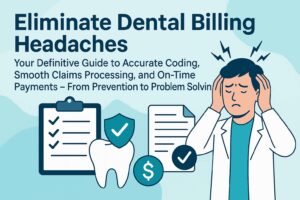
Starting a Dental Practice in 2024: A Comprehensive Guide to Dental Billing

If you’re a dentist with dreams of starting your own dental practice, now is the perfect time to take the leap. Owning your practice not only offers independence and flexibility but also gives you control over your business and the potential for financial success. However, venturing into practice ownership comes with its challenges, especially when it comes to managing dental billing effectively.
In this comprehensive guide, we will walk you through the essential steps to start your dental practice in 2024, with a particular focus on dental billing. We’ll cover everything from understanding the current landscape of dental billing to creating a solid financial plan and attracting patients to your practice. So, let’s dive in and explore the world of dental billing together.
The Importance of Dental Billing in Your Practice
Before we delve into the specifics of starting a dental practice, it’s crucial to understand the significance of dental billing in the context of your business. Dental billing encompasses the process of submitting and managing insurance claims, handling patient payments, and ensuring accurate reimbursement for the services you provide.
Effective dental billing practices are essential for maintaining the financial health of your practice. By optimizing your billing processes, you can streamline revenue collection, reduce claim denials, and enhance overall practice profitability. Outsourcing dental billing services to professionals, like One Dental Billing, can save you time and money while ensuring accurate and timely reimbursement.
Understanding the Current Landscape of Dental Billing in 2024
To navigate the world of dental billing successfully, it’s essential to stay informed about the current trends and expectations in the industry. In 2024, dental billing is experiencing significant transformations, driven by advancements in technology and changes in insurance policies. Let’s explore some of the key factors shaping the landscape of dental billing today:
Digitalization and Automation: Technology plays a crucial role in streamlining dental billing processes. Electronic claims submission, online payment portals, and automated coding systems are becoming the norm, reducing administrative burdens and improving efficiency.
Insurance Policy Changes: Keeping up with changes in insurance policies is vital for accurate billing. Stay informed about policy updates, coverage limitations, and reimbursement rates to ensure optimal billing practices.
Increasing Patient Financial Responsibility: With rising deductibles and out-of-pocket expenses, patients are shouldering a larger portion of the cost of dental care. It’s crucial to communicate clearly with patients about their financial responsibilities and provide transparent pricing information.
Regulatory Compliance: Dental practices must adhere to various regulatory requirements, such as HIPAA regulations and coding standards. Staying compliant with these regulations is crucial to avoid penalties and ensure the privacy and security of patient information.
Focus on Patient Experience: Providing exceptional patient experience extends to the billing process. Simplifying billing statements, offering multiple payment options, and addressing patient concerns promptly can enhance patient satisfaction and loyalty.
Step 1: Create a Solid Business Plan
Before you can dive into the intricacies of dental billing, it’s essential to develop a solid business plan that serves as the foundation for your practice. A well-crafted business plan outlines your goals, strategies, and financial projections. Here are the key elements to include in your dental practice business plan:
Executive Summary
The executive summary provides an overview of your business plan, highlighting your practice’s unique value proposition, target market, and financial projections. It should capture the attention of potential investors and lenders and provide a concise snapshot of your practice’s potential for success.
Practice Overview
In this section, provide detailed information about your practice, including its name, location, specialization, and the services you plan to offer. Describe your target market, competition analysis, and the unique aspects that set your practice apart from others.
Market Analysis
Conduct thorough market research to understand the local dental market, demographics, and competition. Identify gaps and opportunities in the market and explain how your practice will address them. Analyze the demand for dental services, insurance coverage, and patient preferences to develop effective marketing and billing strategies.
Marketing and Sales Strategy
Outline your marketing and sales strategies to attract and retain patients. Identify the most effective channels to reach your target audience, whether through digital marketing, traditional advertising, or community outreach. Develop a referral program and establish partnerships with local businesses to expand your patient base.
Financial Plan
The financial plan is a critical component of your business plan. It should include a detailed budget, projected revenue, and expenses for the first few years of your practice. Estimate the initial investment required for equipment, technology, staff salaries, and marketing efforts. Consider seeking professional advice from a dental accountant or financial advisor to ensure accuracy and feasibility.
Funding Options
Evaluate various funding options to finance your dental practice. Self-funding, bank loans, partnerships, and grants are common options for financing a new practice. Research eligibility criteria, interest rates, repayment terms, and projected cash flows to make informed decisions. Consider highlighting the benefits of outsourcing dental billing to a specialized company, like One Dental Billing, to optimize your financial resources.
Step 2: Set Up Your Dental Billing Processes
Once you have a solid business plan in place, it’s time to establish efficient dental billing processes. Effective dental billing ensures accurate reimbursement, minimizes claim denials, and improves cash flow. Here’s a step-by-step guide to setting up your dental billing processes:
1. Select a Dental Practice Management Software
Invest in a reliable dental practice management software that integrates billing, scheduling, and patient records. Look for software that offers features such as electronic claims submission, automated coding, and real-time eligibility verification. Choose a user-friendly system that aligns with your practice’s specific needs and facilitates seamless billing operations.
2. Hire a Dental Billing Specialist or Outsource to a Dental Billing Company
Consider hiring a dental billing specialist or outsourcing your billing processes to a reputable dental billing company. Dental billing specialists have expertise in navigating insurance policies, coding procedures accurately, and handling claim denials. Outsourcing dental billing allows you to focus on patient care while ensuring efficient revenue cycle management.
3. Verify Insurance Coverage and Benefits
Train your front desk staff to verify patient insurance coverage and benefits before scheduling appointments. Accurate verification helps prevent claim denials and allows you to estimate patients’ out-of-pocket costs accurately. Utilize the features of your practice management software or collaborate with your dental billing specialist to streamline the verification process.
4. Implement Electronic Claims Submission
Transition from paper-based claims to electronic claims submission to expedite the reimbursement process. Electronic claims are processed faster, reducing the turnaround time for payment. Familiarize yourself with the electronic claims submission process and ensure compatibility with insurance carriers and clearinghouses.
5. Streamline Coding and Documentation
Proper coding and documentation are crucial for accurate billing and claim reimbursement. Train your dental team on coding guidelines, including CDT codes for procedures and diagnosis codes for accurate claim submission. Implement standardized documentation practices to ensure complete and compliant patient records.
6. Monitor and Analyze Key Performance Indicators (KPIs)
Regularly monitor and analyze key performance indicators related to your dental billing processes. Track metrics such as claim acceptance rate, average reimbursement time, and accounts receivable turnover to identify areas for improvement. Utilize reporting features within your practice management software or seek guidance from your dental billing specialist to optimize your billing operations.
7. Stay Updated with Dental Billing Regulations and Policies
Stay informed about changes in dental billing regulations, insurance policies, and coding guidelines. Attend continuing education courses, join professional dental associations, and subscribe to industry newsletters to stay up to date. Compliance with regulations ensures accurate billing and minimizes the risk of penalties and legal issues.
8. Foster Communication with Patients
Clear communication with patients regarding billing processes and financial responsibilities is crucial for patient satisfaction. Train your front desk staff to explain insurance coverage, payment options, and any outstanding balances in a friendly and empathetic manner. Provide patients with detailed billing statements and answer any questions promptly and professionally.
Step 3: Attracting Patients to Your Dental Practice
Now that your dental billing processes are in place, it’s time to focus on attracting patients to your practice. Implementing effective marketing strategies is essential for building a strong patient base. Here are some key steps to consider:
1. Develop a Strong Online Presence
Create a professional website for your dental practice that highlights your services, expertise, and patient testimonials. Optimize your website for search engines using relevant keywords, such as “dental billing services” or “dental practice in [your location].” Utilize search engine optimization (SEO) techniques, including well-written content, meta tags, and backlinks, to improve your website’s visibility.
2. Leverage Social Media Platforms
Utilize social media platforms, such as Facebook, Instagram, and LinkedIn, to engage with potential patients. Share informative content, dental health tips, and updates about your practice. Encourage patient reviews and testimonials on social media to build credibility and attract new patients. Consider running targeted advertising campaigns to reach a wider audience.
3. Implement Referral Programs
Encourage satisfied patients to refer their friends and family to your practice by implementing a referral program. Offer incentives, such as discounts on future treatments or free dental hygiene products, to patients who refer new patients. Word-of-mouth referrals are a powerful marketing tool and can significantly contribute to practice growth.
4. Participate in Community Events
Get involved in local community events, health fairs, or school programs to raise awareness about your practice. Set up a booth, distribute informational materials, and offer free dental screenings or consultations. Building relationships within your community can help establish trust and loyalty among potential patients.
5. Provide Exceptional Patient Experience
Deliver exceptional patient experiences from the moment they step foot in your practice. Create a welcoming and comfortable environment, train your staff to provide personalized care, and prioritize patient satisfaction. Implement patient feedback systems to continuously improve your services and address any concerns promptly.
6. Offer Flexible Payment Options
Offer flexible payment options to accommodate patients’ financial needs. Accept various payment methods, including credit cards, electronic fund transfers, and financing options. Collaborate with dental financing companies to provide affordable payment plans to patients who require extensive dental treatments.
Conclusion
Starting a dental practice in 2024 requires careful planning, strategic decision-making, and effective dental billing practices. By creating a solid business plan, implementing efficient dental billing processes, and attracting patients through targeted marketing strategies, you can set your practice up for success. Remember to stay informed about industry trends, comply with dental billing regulations, and prioritize patient satisfaction to build a thriving dental practice. And if you need assistance with dental billing, consider partnering with a trusted dental billing company like One Dental Billing to optimize your revenue cycle management. Good luck on your journey to practice ownership in 2024!
“At One Dental Billing, we specialize in providing comprehensive dental billing services to help dental practices optimize their revenue cycle management. Our team of experienced billing specialists ensures accurate claim submission, timely reimbursement, and efficient accounts receivable management. By partnering with us, you can focus on patient care while we handle your dental billing needs. Contact us today to learn more about how we can support your dental practice’s success.
Contact Us
Phone: 908-357-1515
111 Town Square Pl, Suite 1203 Jersey City, NJ 07310












